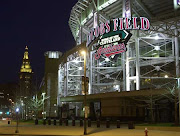A carbon footprint refers to all the direct and indirect sources of harmful emissions that an individual or group produces. Direct sources may include vehicle emissions, while an indirect source could be electricity purchased from a coal fired power plant. A carbon footprint can be applied to an individual, building, or company.
In Cleveland
The Tribe dedicated a new solar energy array at Jacobs Field on June 29 this season. The array is located on the upper concourse overlooking Carnegie Avenue on the firstbase side. The 86 by 15 foot array is mounted on a metal awning structure, allowing fans to pass under the structure. It consists of 42 solar panels with a peak output of 8,400 watts, enough to power the park's 400 television screens during a game.
The total cost of the project was $180,000, with the team contributing $100,000 followed by the Cleveland Foundation ($50,000) and the Ohio Department of Development ($29,400). A $10,000 state grant and a 30% tax credit significantly lowered the cost of the project. "In terms of reducing our electric bill, this is not a huge first step. But it's a first step - and it provides an opportunity for people to start talking about solar and advanced energy" says Jim Folk, vice president of ballpark operations.

 GreenEnergy Ohio will be staffing an informational kiosk at the site to answer any questions fans may have about solar energy or the project.
GreenEnergy Ohio will be staffing an informational kiosk at the site to answer any questions fans may have about solar energy or the project.Around the League
San Francisco became the first team to take advantage of the new program by installing 590 Sharp solar panels around SBC Park. The panels should produce 120,000 watts of electricity at peak production, enough to power the main scoreboard for the entire season. The solar energy will be fed back into the San Francisco grid, off-setting the ballpark's own energy use. Solar panels will be installed in three locations on rooftops and above walkways in SBC Park, with a pending installation for the main scoreboard. Pacific Gas and Electric Company is assisting the Giants with the project.
In addition to existing fluorescent lighting, motion sensors (to turn lights off when no one's there), and energy management systems, the Giants installed a Diamond Vision scoreboard this season. The scoreboard utilizes 78% less energy than the old scoreboard.
Colorado installed a 10,000 watt array in their stadium and are discussing wind energy and lighting projects with Xcel energy. "It will save us over $12,000 a year on our electric bill," according to Greg Feasel, senior vice president of operations for the Rockies. The Boston Red Sox are also researching ways to integrate renewables and a recycling program into their organization.
According to Jim McHale, Major League Baseball's executive vice president for administration, a major initiative will be announced later in the 2007 season. The plan will provide teams with the tools necessary to start their own green projects and will try to inform fans on the importance of renewable energy.
Personally, I'm very excited about MLB's renewable energy initiative. Despite the many benefits of renewable energy like solar and wind, the technologies often require a jump-start to be successful. Solar and wind energy have the potential to off-set a growing energy need and provide a clean alternative or supplement to fossil fuel generated electricity. Start-up costs and public perception are the most common limitations on renewable energy projects, so the endorsement of an organization as large and visible as Major League Baseball is a significant boost to renewable energy in the U.S.
The Jake's solar project is part of a larger drive to ultimately make Cleveland a greener city and bring new technology industries to the city to get the local economy up to speed. Hopefully, small projects like the solar panels at Jacobs Field and the 225 kilowatt turbine at the Great Lakes Science Center can act as a springboard for future renewable energy projects in Northeast Ohio.

Sources: GreenEnergy Ohio Press Release, 6/29/07
The Plain Dealer, 6/13/07
Renewable Energy Access, 3/29/07









No comments:
Post a Comment